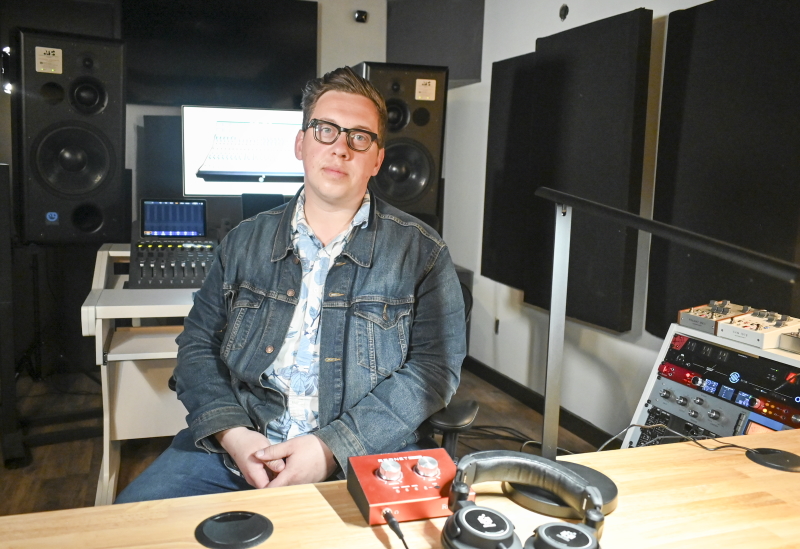Focusrite RedNet Components chosen for Heights Theater Scoring Stage

The historic Heights Theater in Cleveland, Ohio, opened in 1919 as a movie palace, but in more recent years has morphed into a mixed-use community space that encompasses a whiskey bar, a hookah parlor, a Mexican restaurant and a multi-room music recording facility. Studio manager Joel Negus has set his sights on attracting orchestral recording projects to the facility, which can accommodate 100 or more musicians in the main Heights Theater Scoring Stage, and to that end has started building out a Dante®-networked system of Focusrite RedNet converters, microphone preamps and interfaces.
“We're trying to fill a void of large-scale, ensemble recording spaces stateside,” says Negus, a classically trained multi-instrumentalist, composer and producer who has also worked in the jazz, metal and indie genres. “I also want to develop this as an outpost for the L.A. scene,” he adds, leveraging the stellar reputations of the Cleveland Orchestra, Oberlin Conservatory and the Cleveland Institute of Music, where he studied. “Here is another large scoring stage that they can utilize. There are several direct flights a day between Cleveland and L.A., and they ’re very cheap. And you can utilize our players, or you can bring in other people.”
Negus has put together a mobile rack system to capture large ensembles at the highest quality, including 16 channels of Focusrite RedNet MP8R and two RedNet A16R interfaces, handling A/D for 32 channels of other high-end analog mic preamps. In the control room, the primary recording rig utilizes a RedNet PCIeR card and a Red 16Line. We really wanted to invest in some kind of Ethernet-based system, so Dante made sense. And when it comes to Dante, Focusrite represents a go-to brand of components. If somebody is employing a Dante system in a professional recording setting, Focusrite is usually there. There is a reason why you see RedNet in top-tier scoring stages and larger commercial studios,” he says.
“We chose to go the Dante route because the space is so large and because we wanted to network the entire facility, including Studio B upstairs, which used to be the balcony,” he continues. “We wanted to build out the infrastructure to be able to stream in 4K and do remote sessions with people around the world at a high level. We also have some incredible spaces in Cleveland, so for the right project, to be able to roll everything out the door and do a remote session at a cathedral that has a seven-second decay time was also something that we had in mind. All that flexibility is coming from the high-quality conversion that we ’re getting from Focusrite.”

Joel Negus
Negus also employs a RedNet AM2 stereo audio monitoring unit in his control room: “We have one AM2 currently, and we intend to grab additional units. In scoring sessions, there are often numerous people in the control room, so we want them to be able to monitor exactly how they’d prefer, and having the AM2 at the ready helps us facilitate that. And when we want to go elsewhere in the facility, the AM2 is Dante-based, so we can set up monitoring literally anywhere in the building.”
Negus connected with a community of analog synth-based scoring composers in recent years and has produced a number of projects for a variety of visual media as a result of those connections. He is also CEO and co-owner of Cleveland Scoring, a separate company but the stage ’s principal client. “We rent the space here at the Heights Theater the most. Cleveland Scoring is the outward facing entity that ’s contracting high-end scoring sessions for film, television, and video games,” he elaborates. “I just don't think there is a replacement for getting a bunch of people in a room and making some magic. So I really wanted to develop the infrastructure in such a way that engineers from anywhere can come here and have the recording system make sense.”
Getting acquainted with Dante was potentially daunting, as Negus is by no means a network expert. “I was concerned about the learning curve. But after just a few YouTube videos, I’ve been able to figure it out pretty easily. Once you get it, it’s kind of like a patchbay,” says Negus, who grew up in studios, since both his parents are also musicians. “It’s been a rock-solid system. Everything is working the way that it should and just pops up onto the network.”
The renovations in the scoring stage, which boasts a 40-foot ceiling, were led by architectural designer Clifford Benjamin Herring at PAADG Design. Nick Dulworth at Threshold Acoustics consulted on the project, including the 10 striking acoustic panels around the walls, Negus reports. “They are as custom as you can get. Each one of those panels has 1,000 individual cuts of wood that were all put together by hand in the space. About 100 volunteers and neighbors had their hands on them. I spent eight months working 30 hours a week.”
The result is a room with a decay time of around 1.8 seconds, he says, depending on the setup. “We think we have really accomplished something special here before we even get to any of the technology. You can stand on opposite sides of the room and whisper to each other. The clarity comes from about 16 inches of absorption behind all the wood. People can do whatever they want in the mix later, but we ’re just focused on pristine acoustic capture. And Focusrite is helping us translate our room with their brilliant A/D technology.”
 How to resolve AdBlock issue?
How to resolve AdBlock issue?